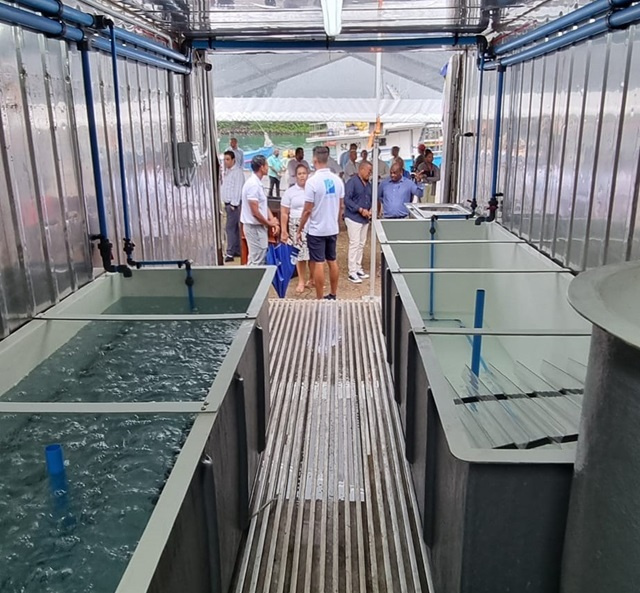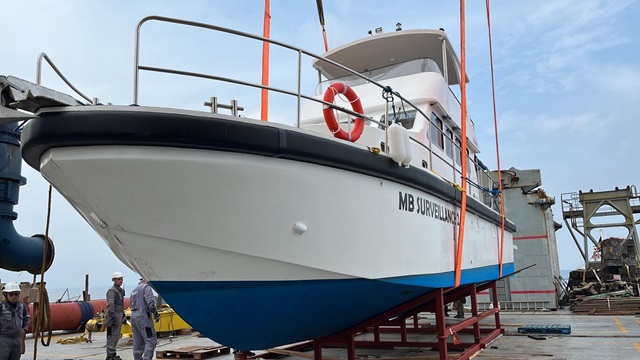SWIOFish3 project ends in Seychelles, Blue Economy expands

Part of the project was setting up a new hatchery located at the Providence fishing port on the main island of Mahe. (Seychelles Aquaculture/Facebook)
(Seychelles News Agency) - The SWIOFish3 project has significantly contributed to the development of entrepreneurship and increased business ventures in the Blue Economy sector in Seychelles over the past five years.
The six-year project, which ended on June 31, provided the foundation for the Blue Investment Funds, which supported innovations in the Blue Economy. Its objective was to improve the management of marine areas and fisheries in targeted zones and strengthen fisheries value chains in the Seychelles, a 115–island archipelago in the western Indian Ocean.
The Third South West Indian Ocean Fisheries Governance and Shared Growth Project (SWIOFish3) was part of the wider World Bank SWIOFish programme, which aimed to increase the economic, social, and environmental benefits of marine fisheries in the southwest Indian Ocean.
SWIOFish3, a government-funded project, was financed by loans and grants from the World Bank and the Global Environment Facility (GEF). The project became effective in April 2018. It was planned to end in June 2023, but it was extended for another year to ensure the implementation of planned activities, which was delayed primarily due to COVID-19 restrictions.
Danielle Jupiter, the project's local manager, told SNA that SWIOFish3 was the project framework for the Blue Bond proceeds issued by the government of Seychelles in 2018.
 |
| Through the SWIOFISH3, SFA managed to acquire a surveillance vessel. (Danielle Jupiter) Photo License: All Rights Reserved |
"Our country made history by issuing the world's first Blue Bond, which is $15 million and has a maturity of 10 years. The proceeds of the Blue Bond are being used to capitalise a Blue Grants Fund ($3 million) and a Blue Investment Fund ($12 million), each of which is providing financing for marine and ocean-related activities that contribute to the transition to sustainable fisheries," explained Jupiter.
Jupiter added that the two funds were designed to complement each other. "For example, an individual can apply for a Blue Grant Fund to test a business idea, and if it works, that person can apply for a Blue Investment Fund loan."
"The Blue Bond really helped put Seychelles on the international map as an innovation hub for new forms of sustainable financing, favouring the environment, conservation, and climate adaptation. Following our example, countries like Belize and Fiji have issued their own Blue Bonds," said Jupiter.
When Seychelles launched the world's first sovereign Blue Bond, it raised $15 million from international investors, demonstrating the potential for countries to harness capital markets to finance the sustainable use of marine resources. The World Bank assisted in developing the bond and reaching out to the three investors: Calvert Impact Capital, Nuveen, and Prudential Financial, Inc.
Proceeds from the bond support the expansion of marine protected areas, improved governance of priority fisheries, and the development of the Seychelles' Blue Economy. Grants and loans provided through the Blue Grants Fund are managed by the Seychelles Conservation and Climate Adaptation Trust (SeyCCAT), while the Blue Investment Fund is accessed through the Development Bank of Seychelles (DBS).
The SWIOFish3 project also brought many other benefits to the islands, including funds for research, which provided data and findings, and critical inputs for the development of fact-based policies and decisions, which were crucial for the project objective. It also provided capacity building for Seychellois in various fields. Through the SWIOFISH3, the Seychelles Fishing Authority (SFA) managed to acquire a surveillance vessel at the cost of $920,000 to help with monitoring and surveillance of the Mahe Plateau.
Furthermore, through the project, the first aquaculture containerised echinoderm hatchery was opened this year at the aquaculture facility located at Providence on the east coast of the main island of Mahe.
The SWIOFish3 project was implemented in four components: expanded sustainable-use marine protected areas, improved governance of priority fisheries, sustainable development of the Blue Economy, and project management and coordination.





